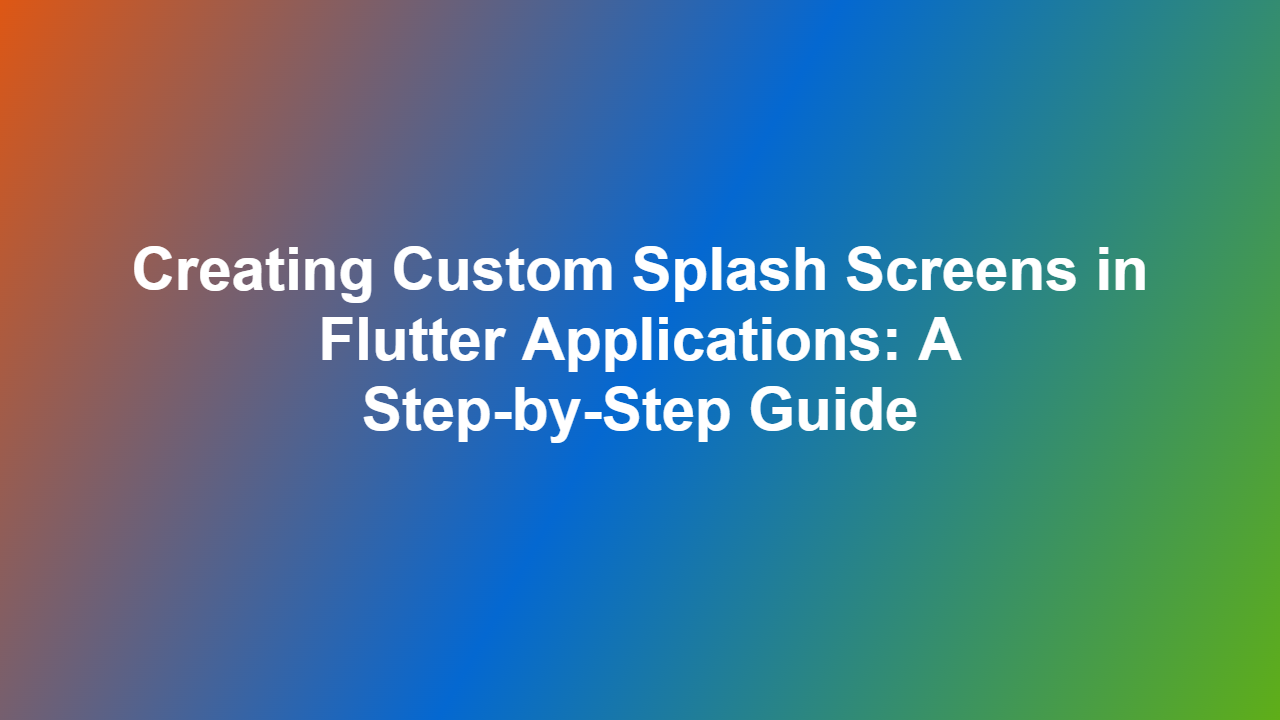Creating Custom Splash Screens in Flutter Applications: A Step-by-Step Guide
Introduction
When building a Flutter application, having a customized splash screen can significantly impact the user experience. A well-designed splash screen can grab the user’s attention, convey the application’s branding, and load essential resources before the main application loads. However, implementing a custom splash screen in Flutter can be a challenging task, especially for beginners. In this article, we will break down the process of creating a splash screen in Flutter and provide a step-by-step guide to achieve a minimalistic splash screen.
What is a Splash Screen?
A splash screen, also known as a preload screen or loading screen, is a graphical interface that appears while an application is loading its content. Its primary purpose is to display a visual element that indicates the application is loading and give it some time to load essential resources, such as fonts, images, and layouts.
Benefits of a Custom Splash Screen
Implementing a custom splash screen in Flutter offers several benefits:
- Improved user experience: A splash screen can convey the application’s branding and provide a seamless transition between the splash screen and the main application.
- Enhanced branding: A custom splash screen allows you to display your brand’s colors, logos, and typography, creating a cohesive user experience.
- Better performance: A splash screen can give the application time to load essential resources, improving its overall performance and reliability.
Creating a Custom Splash Screen
To create a custom splash screen in Flutter, you’ll need to add a new widget to your project and set it as the initial route. Here’s a step-by-step guide:
#### Step 1: Create a new splash screen widget
Create a new file called `splash_screen.dart` and add the following code:
“`dart
import ‘package:flutter/material.dart’;
class SplashScreen extends StatefulWidget {
@override
SplashScreenState createState() => SplashScreenState();
}
class _SplashScreenState extends State
@override
void initState() {
super.initState();
Future.delayed(Duration(seconds: 5), () {
Navigator.pushReplacement(
context,
MaterialPageRoute(builder: (context) => YourMainApplicationWidget()),
);
});
}
@override
Widget build(BuildContext context) {
return Scaffold(
backgroundColor: Colors.blue,
body: Center(
child: Column(
mainAxisAlignment: MainAxisAlignment.center,
children: [
Image.asset(
‘assets/yourbrandlogo.png’,
width: 200,
height: 200,
),
Text(
‘Your Application Name’,
style: TextStyle(fontSize: 24, color: Colors.white),
),
CircularProgressIndicator(),
],
),
),
);
}
}
“`
In this code, we’ve created a new `SplashScreen` widget that displays a splash screen with a logo, a title, and a progress indicator.
#### Step 2: Set the splash screen as the initial route
Update your `MaterialApp` widget in your `main.dart` file to use the `SplashScreen` as the initial route:
“`dart
void main() {
runApp(
MyApp(
title: ‘Your Application Name’,
home: SplashScreen(),
),
);
}
“`
Conclusion
In this article, we’ve explored the importance of creating a custom splash screen in Flutter applications. By following the step-by-step guide outlined above, you can create a minimalistic splash screen that enhances the user experience and provides a seamless transition between the splash screen and the main application.
Frequently Asked Questions (FAQs)
Q: What are the benefits of a custom splash screen in Flutter?
A: Custom splash screens enhance the user experience, improve branding consistency, and provide better performance.
Q: How do I create a custom splash screen in Flutter?
A: Create a new widget, add a `Future.delayed` function to navigate to the main application after a specified delay, and set the splash screen as the initial route in your `MaterialApp` widget.
Q: What should I display in the splash screen?
A: Display a visual element that indicates the application is loading, such as a logo, a title, and a progress indicator.
Q: How do I handle errors in the splash screen?
A: Use try-catch blocks to handle any errors that may occur while loading the splash screen. If an error occurs, display an error message and navigate to an error screen.
Q: Can I create a splash screen with animations?
A: Yes, you can create a splash screen with animations using Flutter’s animation libraries, such as `AnimatedBuilder` and `TweenAnimationBuilder`.
Q: How do I customize the splash screen’s appearance?
A: Customize the splash screen’s appearance by adjusting its design, colors, fonts, and layout. Use Flutter’s widget library to create a visually appealing splash screen that aligns with your application’s branding.
